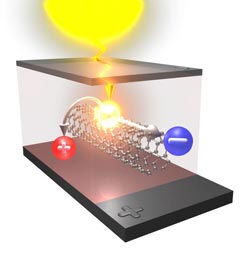Photovoltaics with Nanotubes

Sunlight is absorbed by carbon nanotubes and used for the generation of electrical power.<br><br>Picture: Hannes Kraus / Florian Späth<br>
The conversion of solar energy into electrical power plays a major role in the successful transition to renewable energy sources. Although conventional silicon solar cells have come to be highly efficient, their production is expensive and consumes a lot of energy. Therefore, it is certainly worthwhile to look for alternatives.
Properties of the material are promising
For this reason, a new research network is going to determine which materials are suitable for the photovoltaics of the future. Tiny tubes of pure carbon that are arranged into larger structures seem to be excellent candidates: “This material has many properties holding considerable promise for a highly efficient energy conversion,” says Professor Tobias Hertel of the University of Würzburg.
The material is interesting for photovoltaics due to its great stability and exceptionally high electron mobility. It also has a light absorption spectrum – not easily attainable by any other materials – that is very suitable for energy conversion.
The researcher's objectives
“Although we have been working in the field of organic photovoltaics for years, our first experiments with the high-grade nanotubes didn't fail to thrill and motivate us,” recounts Hertel's Würzburg project partner, Professor Vladimir Dyakonov.
The scientists now intend to further explore the photovoltaic potential of carbon nanotube polymer composites. Special focus is put on the development of socalled functional composite systems. The properties of these systems are to be analyzed with cutting-edge spectroscopic methods.
Training of young researchers important
Apart from the research, the training of doctoral students and postdoctoral researchers in science and industry is an essential objective of the project. On their respective location, the project partners offer courses, industrial internships and workshops in order to provide young researchers with expert knowledge and to prepare them for an academic career.
Project partners and coordination
The project is called POCAONTAS (Polymer-Carbon Nanotubes Active Systems for Photovoltaics). Apart from the Würzburg study groups of Professor Tobias Hertel (chemistry) and Professor Vladimir Dyakonov (physics), it includes further research groups from Munich and five other European countries. Several companies, including two from Bavaria, and the Bavarian Research Alliance have also joined in. The project is coordinated by Professor Larry Lüer (Madrid).
Under the “Initial Training Network” program, the European Union will fund the project with altogether EUR 3.5 million over a period of four years, starting from 1 November 2012. According to Professor Hertel, there is a fierce competition for the funds: “Only very few projects that have been recognized as excellent receive such grants.”
Contact person
Prof. Dr. Tobias Hertel, Institute of Physical and Theoretical Chemistry of the University of Würzburg, T +49 (0)931 31-86300, tobias.hertel@uni-wuerzburg.de
Media Contact
More Information:
http://www.uni-wuerzburg.deAll latest news from the category: Physics and Astronomy
This area deals with the fundamental laws and building blocks of nature and how they interact, the properties and the behavior of matter, and research into space and time and their structures.
innovations-report provides in-depth reports and articles on subjects such as astrophysics, laser technologies, nuclear, quantum, particle and solid-state physics, nanotechnologies, planetary research and findings (Mars, Venus) and developments related to the Hubble Telescope.
Newest articles

A universal framework for spatial biology
SpatialData is a freely accessible tool to unify and integrate data from different omics technologies accounting for spatial information, which can provide holistic insights into health and disease. Biological processes…

How complex biological processes arise
A $20 million grant from the U.S. National Science Foundation (NSF) will support the establishment and operation of the National Synthesis Center for Emergence in the Molecular and Cellular Sciences (NCEMS) at…

Airborne single-photon lidar system achieves high-resolution 3D imaging
Compact, low-power system opens doors for photon-efficient drone and satellite-based environmental monitoring and mapping. Researchers have developed a compact and lightweight single-photon airborne lidar system that can acquire high-resolution 3D…





















